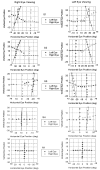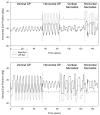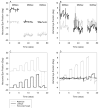Incomitance in monkeys with strabismus
- PMID: 15824015
- PMCID: PMC2553355
- DOI: 10.1080/09273970590910298
Incomitance in monkeys with strabismus
Abstract
Purpose: Rhesus monkeys reared with restricted visual environment during their first few months of life develop large ocular misalignment (strabismus). The purpose of this study was to describe 'A and V' patterns and DVD in these animals during fixation and eye movements and suggest that this form of rearing produces animals that are suitable model to study the mechanisms that might cause 'A/V' pattern incomitant strabismus and dissociated vertical deviation (DVD) in humans.
Methods: Eye movements were recorded during fixation, smooth-pursuit and saccades using binocular search coils in one monkey with esotropia, three monkeys with exotropia and one normal monkey.
Results: 1) Monkeys reared with Alternating Monocular Occlusion or Binocular deprivation (tarsal plates intact) showed both horizontal and vertical misalignment during monocular and binocular viewing. 2) Large 'A' patterns were evident in 2 out of 3 exotropes while a 'V' pattern was observed in the esotrope. 3) Similar 'A/V' patterns were observed with either eye viewing and during fixation or eye movements. 4) The vertical misalignment, which consisted of the non-viewing eye being higher than the fixating eye, appeared to constitute a DVD.
Conclusion: Visual sensory deprivation methods that induce large strabismus also induce 'A/V' patterns and DVD similar to certain types of human strabismus. The source of pattern strabismus could be central, i.e., altered innervation to extraocular muscles from motor nuclei, or peripheral, i.e., altered location of extraocular muscle pulleys.
Figures




References
-
- Urist MJ. Horizontal squint with secondary vertical deviation. Arch Ophthalmol. 1951;46:245–267. - PubMed
-
- Von Noorden GK, Campos EC. Binocular vision and ocular motility: Theory and management of strabismus. 6th Mosby; St. Louis: 2002.
-
- Guyton DL, Weingarten PE. Sensory torsion as the cause of primary oblique muscle overaction/underaction and A- and V-pattern strabismus. Binoc Vis Strabismus Q. 1994;9(3):209–236.
-
- Anderson JR. Ocular vertical deviations and nystagmus. British Medical Association; London: 1959.
Publication types
MeSH terms
Grants and funding
LinkOut - more resources
Full Text Sources
